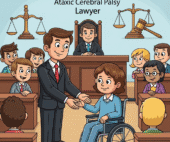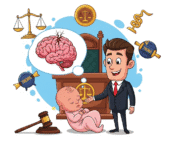In the wake of a birth marked by severe oxygen deprivation – a condition known as Hypoxic-Ischemic Encephalopathy (HIE) – a groundbreaking treatment offers a fragile window of hope: therapeutic hypothermia, or cooling therapy. This specialized intervention, which carefully lowers a newborn’s body temperature, aims to minimize the devastating brain damage that can result from a lack of oxygen around birth. Yet, the precision, timing, and constant vigilance required for effective cooling therapy are paramount. When this complex, critical procedure is mismanaged, delayed, or improperly executed due to medical negligence, the window of hope can tragically close, leading to worsened brain injury and lifelong conditions like cerebral palsy. If your child endured severe oxygen deprivation at birth, underwent cooling therapy, but still suffered profound brain damage, and you suspect that the treatment was negligently handled, you are not navigating this overwhelming reality alone. Our compassionate Therapeutic Cooling Malpractice Lawyers at CPFamilyHelp.com are fiercely dedicated to meticulously investigating substandard medical care, securing accountability, and tirelessly pursuing the comprehensive compensation your child will require for a lifetime of specialized care. When a vital medical intervention fails due to negligence, partnering with a dedicated Therapeutic Cooling Malpractice Lawyer offers a crucial route to justice and support.
Understanding Therapeutic Hypothermia: Cooling for Brain Protection
Therapeutic hypothermia, often referred to as cooling therapy, is a medical treatment used for newborns who have experienced moderate to severe Hypoxic-Ischemic Encephalopathy (HIE). The core principle behind cooling is that by gently lowering the baby’s body temperature for a precise period (usually 72 hours), it slows down damaging processes in the brain that would otherwise continue after oxygen is restored. This allows brain cells to recover and reduces inflammation and cell death, potentially minimizing the extent of neurological injury.
This therapy is highly time-sensitive: to be most effective, cooling must ideally begin within six hours of the birth injury (the “therapeutic window”). It involves two main phases:
- Cooling Phase: The baby’s core body temperature is lowered and maintained at a specific target (e.g., 33.5°C or 92.3°F) for 72 hours, using special cooling blankets or caps.
- Rewarming Phase: After 72 hours, the baby is slowly and carefully rewarmed over several hours (typically 6-12 hours) to avoid rapid temperature changes that could cause further harm.
Throughout both phases, the baby requires continuous, intensive monitoring of vital signs, blood work, and neurological activity in a specialized NICU setting. The strict adherence to established protocols for this complex intervention is non-negotiable. Any deviation or delay can be critical, making it a key focus for a Therapeutic Cooling Malpractice Lawyer.
The Alarming Link: Medical Negligence in Therapeutic Cooling Leading to Worsened HIE
While therapeutic hypothermia is a powerful tool, its effectiveness can be compromised by medical negligence, leading to worsened brain injury from HIE. Our Therapeutic Cooling Malpractice Lawyers specialize in meticulously investigating these critical failings in the standard of care:
- Failure to Recognize the Need for Cooling Therapy:
- Cause: Missing or underestimating the signs of moderate to severe HIE in a newborn (e.g., abnormal muscle tone, depressed consciousness, seizures, low Apgar scores, abnormal cord blood gas).
- Relation to Negligence: Inadequate neurological assessment at birth, misinterpretation of initial symptoms, or failure to order necessary diagnostic tests that would indicate HIE severity. This delay pushes the baby beyond the critical therapeutic window.
- Delayed Initiation of Cooling Therapy:
- Cause: Even when HIE is recognized, hesitation or operational delays in starting the cooling process within the crucial 6-hour window.
- Relation to Negligence: Slow decision-making by the medical team, lack of preparedness for cooling, or hospital systemic failures that prevent rapid transfer to a facility equipped for cooling. A Therapeutic Cooling Malpractice Lawyer will scrutinize the exact timeline from birth to cooling initiation.
- Improper Execution or Monitoring During Cooling Phase:
- Cause: Not maintaining the target temperature precisely, inadequate monitoring of vital signs (which can become unstable during cooling), or failing to manage potential complications (e.g., blood pressure fluctuations, clotting issues, infections).
- Relation to Negligence: Errors in operating cooling equipment, insufficient nursing vigilance, or inadequate medical response to physiological changes during therapy.
- Errors During the Rewarming Phase:
- Cause: Rewarming the baby too quickly after the 72-hour cooling period. Rapid rewarming can cause secondary brain injury (reperfusion injury) or trigger seizures.
- Relation to Negligence: Deviation from established, gradual rewarming protocols, directly exacerbating brain damage.
In these highly specialized and time-sensitive medical scenarios, meticulous precision and constant vigilance are paramount. When medical professionals fail to meet this standard, our Therapeutic Cooling Malpractice Lawyers are here to hold them accountable.
Recognizing the Devastating Outcomes: Worsened HIE and Cerebral Palsy
When therapeutic hypothermia is mismanaged, the potential benefits are diminished, leading to more severe and often permanent brain damage from HIE. Our Therapeutic Cooling Malpractice Lawyers help families whose children suffer from:
- Worsened Hypoxic-Ischemic Encephalopathy (HIE): The initial brain injury is exacerbated, leading to more extensive and profound damage to brain regions critical for function.
- Cerebral Palsy (CP): Severe HIE is a leading cause of cerebral palsy, affecting a child’s movement, muscle tone, or posture. The type and severity of CP (e.g., spastic, dyskinetic) directly correlate with the extent of brain damage, which can be worsened by negligent cooling.
- Severe Developmental Delays: Impairments in cognitive function, motor skills, speech, and learning abilities that are more profound than they might have been with proper cooling.
- Refractory Seizure Disorders/Epilepsy: Brain damage from exacerbated HIE often triggers chronic, difficult-to-control seizures.
- Intellectual Disabilities: Varying degrees of cognitive impairment.
- Vision and Hearing Impairments: Due to damage to the brain’s sensory processing centers.
If your child suffered profound brain damage from HIE, despite receiving or being a candidate for cooling therapy, and you suspect that the therapy was negligently handled, you likely have strong grounds to consult with a Therapeutic Cooling Malpractice Lawyer.
The Lifelong Impact and Why a Therapeutic Cooling Malpractice Lawyer is Essential
A diagnosis of severe HIE leading to cerebral palsy or other profound neurological impairments stemming from mismanaged therapeutic hypothermia means a child faces a future requiring extensive, lifelong specialized care. The financial and emotional implications for medical treatments, therapies, specialized equipment, and potentially round-the-clock personal assistance are staggering, often running into millions of dollars over a child’s lifetime. Securing comprehensive compensation through a medical malpractice lawsuit is not merely about financial recovery; it is about providing your child with every resource needed to achieve their highest potential and live the most fulfilling life possible despite their challenges. This is precisely why the expertise of a dedicated Therapeutic Cooling Malpractice Lawyer is so profoundly important.
The substantial costs that compensation typically aims to cover include:
- Ongoing Medical Treatment: Pediatric neurologists, rehabilitation doctors, specialized therapists, medications for seizures or spasticity, and frequent diagnostic tests (e.g., ongoing brain imaging, EEGs).
- Intensive Therapies: Lifelong physical, occupational, speech-language, and possibly behavioral or aquatic therapies.
- Specialized Equipment: Wheelchairs, walkers, braces, communication devices, assistive technology, and adapted vehicles.
- Home Modifications: Necessary renovations to your home to ensure accessibility and safety.
- Special Education and Vocational Training: Tailored learning environments and job skills training to maximize independence.
- Personal Care Assistance: Potentially 24/7 in-home nursing or attendant care for severe cases.
- Loss of Earning Capacity: Compensation for your child’s diminished ability to earn an income as an adult.
- Pain, Suffering, and Emotional Distress: The profound non-economic toll on the child and family.
Our dedicated team at CPFamilyHelp.com is passionate about ensuring your child receives the maximum compensation necessary to cover these extensive, lifelong needs. We are your trusted Therapeutic Cooling Malpractice Lawyers, fighting tirelessly for their future.
How Our Therapeutic Cooling Malpractice Lawyers Build Your Case for Justice
If you are convinced that your child’s HIE-related birth injury was caused or worsened by medical negligence in the administration of therapeutic hypothermia, you have a right to pursue a medical malpractice lawsuit. These cases are incredibly complex, demanding profound understanding of neonatology, brain injury pathology, and sharp legal acumen. Our Therapeutic Cooling Malpractice Lawyers at CPFamilyHelp.com are uniquely equipped to handle these intricate claims.
We will:
- Conduct a Thorough and Expert-Driven Investigation: Our investigators will meticulously review all prenatal, labor, delivery, and postnatal medical records, with a particular focus on the exact timing of the HIE event, documentation of initial neurological status, cooling therapy initiation time, temperature logs throughout cooling and rewarming, monitoring records (vital signs, labs, EEG), and records of any complications during therapy. We look for crucial details such as delays in initiation, improper temperature management, or inadequate monitoring. This thoroughness is the bedrock of our practice as a Therapeutic Cooling Malpractice Lawyer.
- Collaborate with Premier Medical Experts: We partner with a network of top neonatologists specializing in HIE and cooling therapy, pediatric neurologists, neuroradiologists, and other experts. Their invaluable professional opinion will clarify how the deviation from the standard of care in therapeutic cooling led to your child’s worsened brain injury and subsequent cerebral palsy, and they will help us accurately estimate the considerable financial needs for your child’s lifetime (Life Care Planning Birth Injury). This expert collaboration is a cornerstone of our effective Therapeutic Cooling Malpractice Lawyer representation.
- Navigate Complex Legal Frameworks: Birth injury lawsuits involving therapeutic cooling are highly intricate, demanding precise adherence to legal standards. Our Therapeutic Cooling Malpractice Lawyers possess deep knowledge of the specific legal mandates, procedural rules, and the important statute of limitations for birth injury claims in your state. We ensure your case is prepared flawlessly and filed within all the needed time frames.
- Assertively Pursue Maximum Recovery: Our primary goal is to achieve full compensation that covers all areas of your child’s past, current, and future needs, including all economic and non-economic damages. We fight to bring you and your family the money you need to provide the best possible care and opportunities for your child throughout their lifetime.
You and your child deserve accountability and the resources to thrive. For powerful Therapeutic Cooling Malpractice Lawyer representation that truly understands your fight, turn to CPFamilyHelp.com.
Most Frequently Asked Questions (FAQ) about Therapeutic Cooling Mismanagement and Birth Injuries
Is therapeutic hypothermia always effective in preventing HIE brain damage?
Therapeutic hypothermia significantly reduces the risk of death or severe neurodevelopmental impairment in newborns with moderate to severe HIE, but it is not a cure and does not guarantee a full recovery. Its effectiveness is highly dependent on timely and proper administration.
What is the “therapeutic window” for cooling therapy?
Cooling therapy is typically most effective when initiated within 6 hours of the birth asphyxia event. Delays beyond this window significantly diminish its neuroprotective benefits.
Can a baby still get cerebral palsy even if they received cooling therapy?
Yes. Even with cooling therapy, some babies may still develop cerebral palsy or other impairments if the initial brain injury was very severe, or if the cooling therapy itself was not optimally managed. If mismanagement is suspected, a Therapeutic Cooling Malpractice Lawyer can investigate.
What specific aspects of cooling therapy can be subject to malpractice claims?
Claims can arise from delayed initiation of cooling (missing the 6-hour window), improper maintenance of target temperature, inadequate monitoring of the baby’s vital signs during cooling, or incorrect rewarming procedures.
What kind of evidence is crucial in a therapeutic cooling malpractice claim?
Key evidence includes detailed labor and delivery records (time of HIE event), neonatology progress notes, precise temperature logs during cooling and rewarming, vital sign charts, EEG results, brain imaging (MRI) before and after cooling, and expert medical testimony from neonatologists specializing in HIE and cooling therapy. A thorough Therapeutic Cooling Malpractice Lawyer will gather and analyze all this crucial documentation.
If you feel your child’s HIE-related birth injury was caused or worsened by medical negligence in the administration of therapeutic hypothermia, and you’d like to discuss your case with a lawyer, don’t hesitate. For experienced and compassionate Therapeutic Cooling Malpractice Lawyer service, we encourage you to Contact Trusted Birth Injury Lawyers | CPFamilyHelp today for a free and confidential review. We hear you, we advise you, and we advocate for your child’s future.




